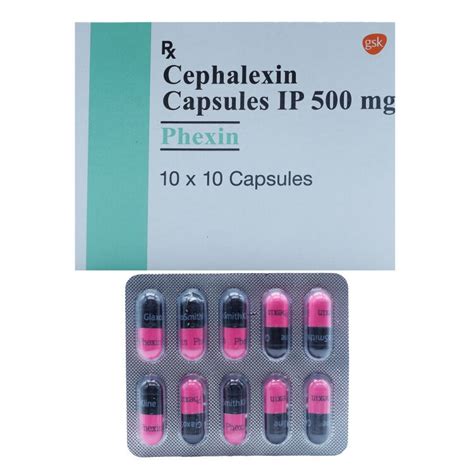Intro
Cephalexin 500mg antibiotic treats bacterial infections, including skin, respiratory, and urinary tract infections, with effective antimicrobial properties and minimal side effects.
Cephalexin, commonly known by its brand name Keflex, is a type of antibiotic that belongs to the group of cephalosporins. It is used to treat bacterial infections by inhibiting the growth of bacteria. Cephalexin 500mg is a specific dosage of this medication, which is available in capsule or tablet form. The importance of understanding the uses, benefits, and potential side effects of cephalexin cannot be overstated, especially for individuals who have been prescribed this antibiotic.
The role of antibiotics like cephalexin in modern medicine is crucial. They provide effective treatment options for a wide range of bacterial infections that could otherwise lead to serious health complications. Cephalexin, in particular, is valued for its broad-spectrum activity, meaning it can target a variety of bacteria. This versatility makes it a popular choice among healthcare providers for treating various infections. However, like all antibiotics, cephalexin must be used judiciously and under medical supervision to minimize the risk of side effects and the development of antibiotic-resistant bacteria.
The mechanism of action of cephalexin involves interfering with the synthesis of the bacterial cell wall, ultimately leading to the death of the bacterial cells. This action is specific to bacteria and does not affect human cells, making cephalexin a relatively safe treatment option for bacterial infections. Understanding how cephalexin works is essential for appreciating its effectiveness and limitations. It is also important to note that cephalexin is not effective against viral infections, such as the common cold or flu, which is a common misconception among patients.
Cephalexin 500mg Uses

Cephalexin 500mg is prescribed for a variety of bacterial infections. Some of the most common uses include the treatment of respiratory tract infections, such as pneumonia and bronchitis, skin and soft tissue infections, like cellulitis and abscesses, and urinary tract infections (UTIs), including cystitis and pyelonephritis. It is also used to treat bone infections (osteomyelitis) and certain types of bacterial infections of the genitals.
The benefits of using cephalexin 500mg include its effectiveness in treating bacterial infections, relatively mild side effect profile compared to other antibiotics, and its availability in various forms, which can be convenient for patients with different needs. For example, cephalexin capsules or tablets can be taken orally, making it easy to administer at home.
Benefits of Cephalexin
The benefits of cephalexin can be outlined as follows: - Effective against a broad spectrum of bacteria - Relatively safe with a low risk of serious side effects - Available in different formulations for ease of use - Can be used in patients who are allergic to penicillin, although caution is advised due to the risk of cross-reactivityWorking Mechanism of Cephalexin

The working mechanism of cephalexin involves the inhibition of cell wall synthesis in bacteria. Bacteria rely on their cell walls for structural integrity and to maintain the internal environment. By interfering with the synthesis of these cell walls, cephalexin effectively weakens the bacteria, leading to their death. This action is bactericidal, meaning it kills the bacteria rather than just inhibiting their growth.
Steps for Taking Cephalexin
To ensure the effectiveness of cephalexin and minimize the risk of side effects, it is crucial to follow the prescribed dosage and administration instructions. Here are some steps to consider: 1. Take cephalexin exactly as directed by your healthcare provider. 2. The usual dose for adults is 250mg to 500mg, taken every 6 hours. 3. It is essential to complete the full course of treatment, even if symptoms improve before finishing the medication. 4. Cephalexin can be taken with or without food, but taking it with food may help reduce stomach upset.Potential Side Effects of Cephalexin

Like all medications, cephalexin can cause side effects. Common side effects include:
- Diarrhea
- Nausea
- Vomiting
- Abdominal pain
- Headache
- Dizziness
Serious side effects are less common but can include severe allergic reactions, such as anaphylaxis, and Clostridioides difficile (C. diff) associated diarrhea.
Precautions and Warnings
Before taking cephalexin, it is essential to inform your healthcare provider about any allergies, especially to penicillin or other cephalosporins, as there is a risk of cross-reactivity. Additionally, patients with kidney disease may require adjusted doses, and cephalexin should be used with caution in pregnant or breastfeeding women.Cephalexin Interactions

Cephalexin can interact with other medications, including:
- Metformin, used for diabetes
- Probenecid, used for gout
- Warfarin, a blood thinner
These interactions can either increase the risk of side effects or reduce the effectiveness of cephalexin. It is crucial to inform your healthcare provider about all medications, vitamins, and supplements you are taking.
Statistical Data on Cephalexin Effectiveness
Studies have shown that cephalexin is effective in treating a wide range of bacterial infections. For example, in the treatment of streptococcal pharyngitis, cephalexin has been shown to have a high cure rate, often above 90%. Similarly, in urinary tract infections, cephalexin has demonstrated significant efficacy, with clinical response rates typically exceeding 80%.Cephalexin Resistance

The issue of antibiotic resistance is a growing concern worldwide. The overuse and misuse of antibiotics, including cephalexin, contribute to the development of resistant bacteria. This means that infections caused by these bacteria may not respond to cephalexin or other antibiotics, making treatment more challenging.
Practical Examples of Cephalexin Use
Cephalexin is used in various clinical scenarios: - A patient with a skin infection (cellulitis) may be prescribed cephalexin 500mg orally every 6 hours for 7-10 days. - For a patient with a urinary tract infection, cephalexin 500mg may be given every 6 hours for 7-14 days, depending on the severity of the infection.Conclusion and Future Directions

In conclusion, cephalexin 500mg is a valuable antibiotic for treating various bacterial infections. Its effectiveness, coupled with a relatively favorable side effect profile, makes it a commonly prescribed medication. However, the rise of antibiotic-resistant bacteria underscores the need for responsible use of antibiotics like cephalexin. Future research should focus on developing new antibiotics and strategies to combat resistance, ensuring that effective treatments remain available for bacterial infections.
We invite readers to share their experiences with cephalexin or ask questions about its use. Your feedback and insights are invaluable in promoting a better understanding of this important antibiotic. Please feel free to comment below or share this article with others who might benefit from this information.
What is cephalexin used for?
+Cephalexin is used to treat bacterial infections, including respiratory tract infections, skin and soft tissue infections, urinary tract infections, and certain types of genital infections.
How long does it take for cephalexin to work?
+The time it takes for cephalexin to start working can vary depending on the type of infection being treated. Typically, improvements in symptoms can be seen within a few days of starting the medication.
Can cephalexin be used in pregnant women?
+Cephalexin can be used in pregnant women, but it should be prescribed with caution. It is essential to discuss the potential risks and benefits with a healthcare provider.
What are the common side effects of cephalexin?
+Common side effects of cephalexin include diarrhea, nausea, vomiting, abdominal pain, headache, and dizziness. Serious side effects, such as severe allergic reactions, can also occur but are less common.
How does cephalexin interact with other medications?
+Cephalexin can interact with several medications, including metformin, probenecid, and warfarin. It is crucial to inform your healthcare provider about all medications you are taking to avoid potential interactions.
